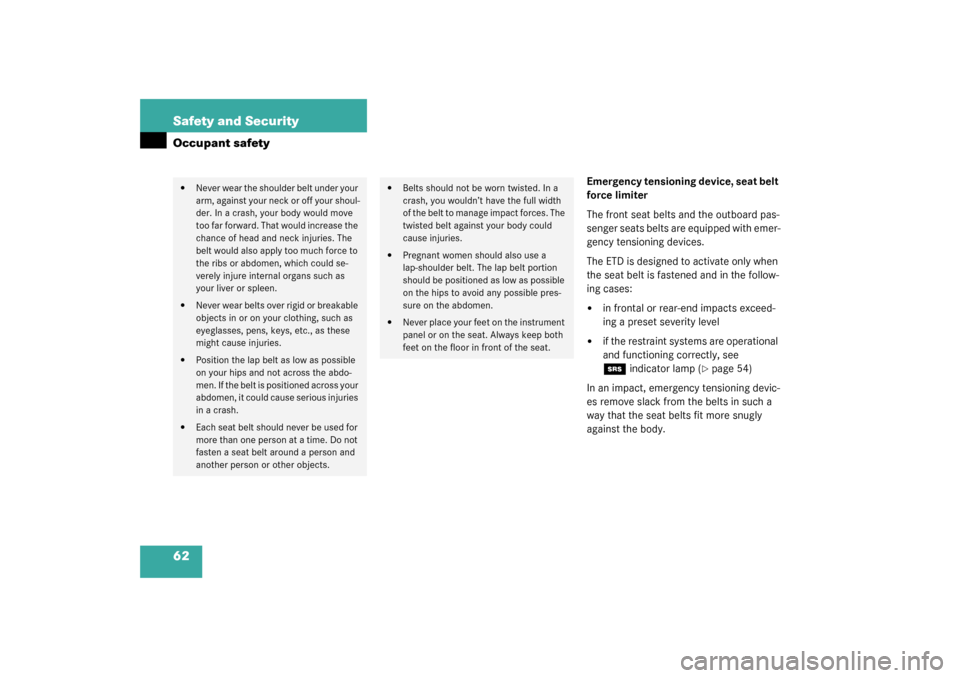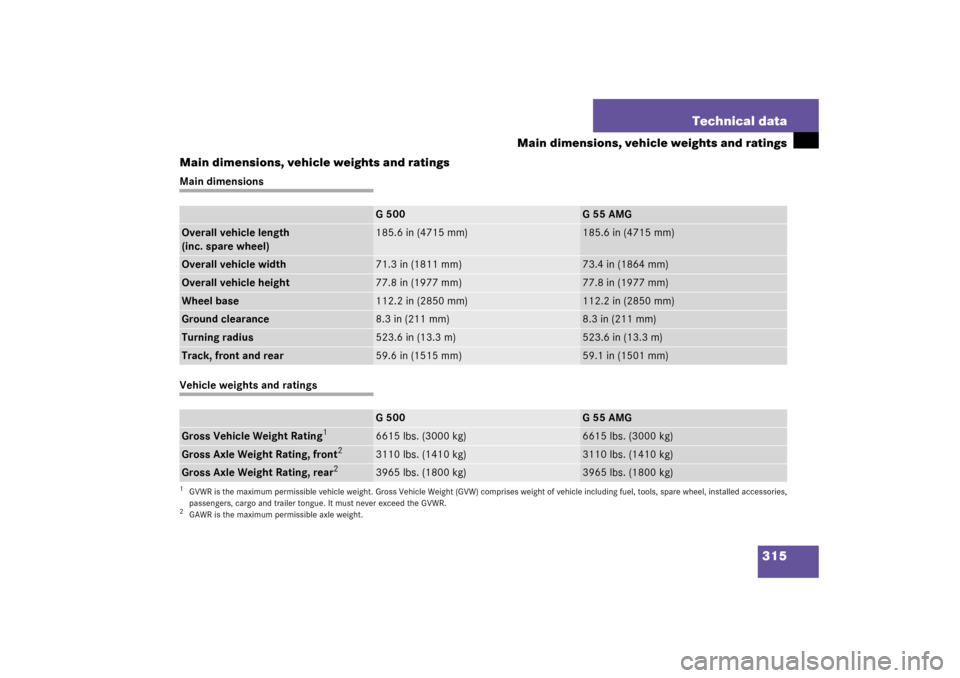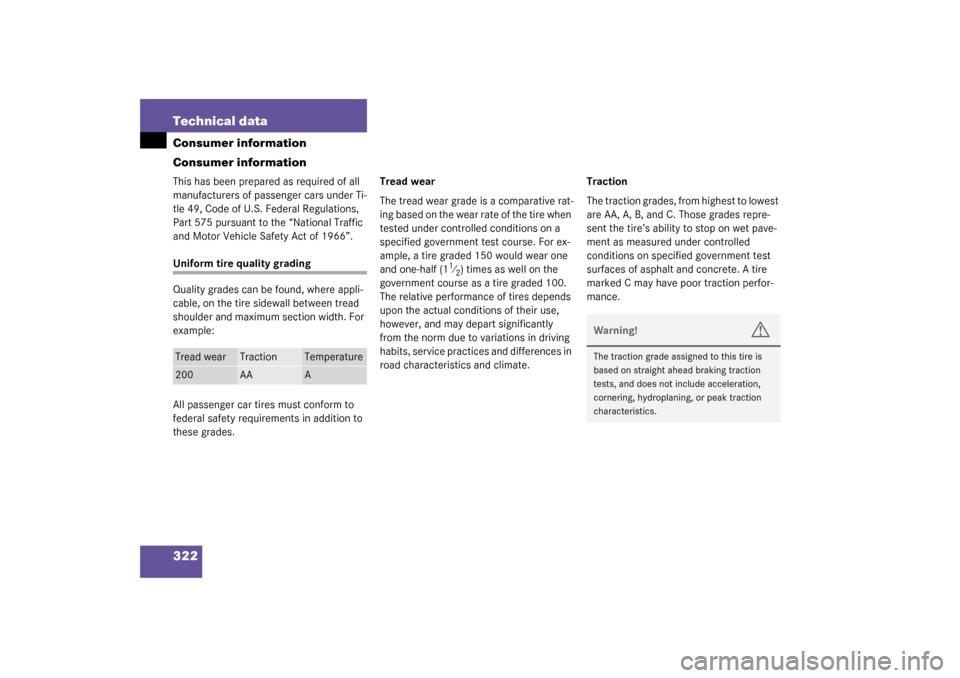Page 62 of 360

62 Safety and SecurityOccupant safety
Emergency tensioning device, seat belt
force limiter
The front seat belts and the outboard pas-
senger seats belts are equipped with emer-
gency tensioning devices.
The ETD is designed to activate only when
the seat belt is fastened and in the follow-
ing cases:�
in frontal or rear-end impacts exceed-
ing a preset severity level
�
if the restraint systems are operational
and functioning correctly, see 1
indicator lamp (
�page 54)
In an impact, emergency tensioning devic-
es remove slack from the belts in such a
way that the seat belts fit more snugly
against the body.
�
Never wear the shoulder belt under your
arm, against your neck or off your shoul-
der. In a crash, your body would move
too far forward. That would increase the
chance of head and neck injuries. The
belt would also apply too much force to
the ribs or abdomen, which could se-
verely injure internal organs such as
your liver or spleen.
�
Never wear belts over rigid or breakable
objects in or on your clothing, such as
eyeglasses, pens, keys, etc., as these
might cause injuries.
�
Position the lap belt as low as possible
on your hips and not across the abdo-
men. If the belt is positioned across your
abdomen, it could cause serious injuries
in a crash.
�
Each seat belt should never be used for
more than one person at a time. Do not
fasten a seat belt around a person and
another person or other objects.
�
Belts should not be worn twisted. In a
crash, you wouldn’t have the full width
of the belt to manage impact forces. The
twisted belt against your body could
cause injuries.
�
Pregnant women should also use a
lap-shoulder belt. The lap belt portion
should be positioned as low as possible
on the hips to avoid any possible pres-
sure on the abdomen.
�
Never place your feet on the instrument
panel or on the seat. Always keep both
feet on the floor in front of the seat.
Page 234 of 360

234 OperationVehicle careVehicle washing
Do not use hot water or wash your vehicle
in direct sunlight. Use only a mild car wash
detergent, such as Mercedes-Benz ap-
proved Car Shampoo.
Thoroughly spray the vehicle with a dif-
fused jet of water. Direct only a very weak
spray towards the ventilation intake. Use
plenty of water and rinse the sponge and
chamois frequently.
Rinse with clear water and thoroughly dry
with a chamois. Do not allow cleaning
agents to dry on the finish.
Due to the width of the vehicle, fold in out-
side mirrors prior to running the vehicle
through an automatic car wash to prevent
damage to the mirrors.
In the winter, thoroughly remove all traces
of road salt as soon as possible.
When washing the underbody, do not for-
get to clean the inner sides of the wheels.Ornamental moldings
For regular cleaning and care of very dirty
chrome-plated parts, use a chrome clean-
er.
Headlamps, tail lamps, turn signal
lenses
Use a mild car wash detergent, such as
Mercedes-Benz approved Car Shampoo,
with plenty of water.
To prevent scratches, never apply strong
force and use only a soft, non-scratchy
cloth when cleaning the lenses. Do not at-
tempt to wipe dirty lenses with a dry cloth
or sponge.Cleaning the Rear Park Assist sensors*
1Sensor
Use a mild car wash detergent, such as
Mercedes-Benz approved Car Shampoo,
with plenty of water to clean sensor1.
To prevent scratches, never apply strong
force and use only a soft, non-scratchy
cloth when cleaning the sensor. Do not at-
tempt to wipe dirty sensors with a dry cloth
or sponge.
Page 315 of 360

315 Technical data
Main dimensions, vehicle weights and ratings
Main dimensions, vehicle weights and ratings
Main dimensionsVehicle weights and ratings
G500
G55AMG
Overall vehicle length
(inc. spare wheel)
185.6 in (4715 mm)
185.6 in (4715 mm)
Overall vehicle width
71.3 in (1811 mm)
73.4 in (1864 mm)
Overall vehicle height
77.8 in (1977 mm)
77.8 in (1977 mm)
Wheel base
112.2 in (2850 mm)
112.2 in (2850 mm)
Ground clearance
8.3 in (211 mm)
8.3 in (211 mm)
Turning radius
523.6 in (13.3 m)
523.6 in (13.3 m)
Track, front and rear
59.6 in (1515 mm)
59.1 in (1501 mm)
G500
G55AMG
Gross Vehicle Weight Rating
1
1GVWR is the maximum permissible vehicle weight. Gross Vehicle Weight (GVW) comprises weight of vehicle including fuel, tools, spare wheel, installed accessories,
passengers, cargo and trailer tongue. It must never exceed the GVWR.
6615 lbs. (3000 kg)
6615 lbs. (3000 kg)
Gross Axle Weight Rating, front
2
2GAWR is the maximum permissible axle weight.
3110 lbs. (1410 kg)
3110 lbs. (1410 kg)
Gross Axle Weight Rating, rear
2
3965 lbs. (1800 kg)
3965 lbs. (1800 kg)
Page 322 of 360

322 Technical dataConsumer information
Consumer informationThis has been prepared as required of all
manufacturers of passenger cars under Ti-
tle 49, Code of U.S. Federal Regulations,
Part 575 pursuant to the “National Traffic
and Motor Vehicle Safety Act of 1966”.Uniform tire quality grading
Quality grades can be found, where appli-
cable, on the tire sidewall between tread
shoulder and maximum section width. For
example:
All passenger car tires must conform to
federal safety requirements in addition to
these grades.Tread wear
The tread wear grade is a comparative rat-
ing based on the wear rate of the tire when
tested under controlled conditions on a
specified government test course. For ex-
ample, a tire graded 150 would wear one
and one-half (1
1⁄2) times as well on the
government course as a tire graded 100.
The relative performance of tires depends
upon the actual conditions of their use,
however, and may depart significantly
from the norm due to variations in driving
habits, service practices and differences in
road characteristics and climate.Traction
The traction grades, from highest to lowest
are AA, A, B, and C. Those grades repre-
sent the tire’s ability to stop on wet pave-
ment as measured under controlled
conditions on specified government test
surfaces of asphalt and concrete. A tire
marked C may have poor traction perfor-
mance.
Tread wear
Traction
Temperature
200
AA
A
Warning!
G
The traction grade assigned to this tire is
based on straight ahead braking traction
tests, and does not include acceleration,
cornering, hydroplaning, or peak traction
characteristics.